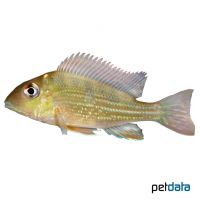Suriname Eartheater (Geophagus proximus)
| Suriname Eartheater Geophagus proximus | |
|---|---|
| Name | Suriname Eartheater |
| Name Lat. | Geophagus proximus |
| Family | Cichlids |
| Family lat. | Cichlidae |
| Order | Cichlids |
| Order lat. | Cichliformes |
| Origin | Peru |
| Habitat | Rivers, lakes |
| Diet | Omnivore |
| pH | 6.5-7.5 |
| Behavior | ♂ territorial |
| Keeping | Pair |
| Care Level | Difficult |
| Reproduction | Mouthbrooder |
| Breeding | Moderately difficult |
| Life Span | 8-12 years |
| Protection | No |
| Metric Units | |
| Size | 20-22 cm |
| Temperature | 24-28 °C |
| Hardness | 2-15 °dH |
| Aquarium | ~ 400 l |
| US Units | |
| Size | 8"-8.7" |
| Temperature | 75-82 °F |
| Hardness | 36-267 ppm |
| Aquarium | ~ 100 gal |
Distribution and habitat
The range of the Surinam Pearlfish extends from the Ucayali tributaries in Peru, along the Peruvian and Brazilian Amazon to the vicinity of Santarém (Pará, Brazil). In slow-flowing or stagnant waters, they prefer the lakeshore zones and bays of larger rivers.
Maintenance
The aquarium should be equipped with hiding places (crevices and caves) from stones and roots, as well as robust planting. A deep layer of sand and some subdued light (floating plants) are ideal.
No ammonia, ammonium or nitrite should be detectable in the water, and the nitrate level should not exceed 100 mg/l. To ensure water quality and oxygen content, a filter and heater adapted to the aquarium size is required, as well as lighting for the species-appropriate day-night rhythm of the animals.
Diet
The food supply consists of live, frozen and dry food. For a balanced diet, feed once daily with a high-quality sinking dry food (granules, pellets, tablets) as well as tubifex, artemia, mysis, mosquito larvae or shrimp (live or frozen). In addition, they need regular vegetable food, such as blanched leafy and wild vegetables, algae leaves or dry food with vegetable ingredients (e.g. spirulina)
It is recommended to feed small portions several times a day. Only feed as much as will be eaten within a few minutes. A regular and varied diet promotes health and increases resistance.
Behaviour and compatibility
They should be kept in pairs. Males are very territorial within the species, therefore keeping several pairs is only recommended in a larger and richly structured tank. They are relatively compatible with other fish and can be kept together with larger South American cichlids. Basically, only compatible fish species with similar demands on water condition and water temperature should be socialized.
Sex dimorphism
The male usually has a frontal hump and a longer extended dorsal and anal fin, as well as a pointed genital papilla, which is round in the female. It is difficult to determine the sex of juveniles.
Reproduction and breeding
They are larvophilic mouth brooders. The female usually spawns on a well-cleaned, smooth rock. Together the parents care for and guard the clutch. After 3-4 days the larvae hatch and are immediately taken up by the female, sometimes by both parents, into their spacious gullet (pharynx) for mouthbrooding. After about 1-2 weeks, the fry are released, guarded by both parents for a few more days, and led to feeding sites in the aquarium before brood care ends. In case of imminent danger the fry flee back into the mouth of the parents.
Fry must be fed several times a day with special rearing food (Artemia nauplii). In community tanks breeding is hardly possible, because the fry are easy prey.
Important
They rummage through the substrate in search of food. According to this species-typical behavior, they are also called soil eaters. Plants are not eaten, but should be placed in pots and secured with stones against digging out.
The well-being of the fish should be checked regularly. Temperature should be checked daily, pH, hardness and nitrate levels should be checked at least every 14 days. Regular partial water changes are recommended, even if the contaminant level has not yet reached the upper limit. Sudden changes in water quality should be avoided. Newly introduced fish must be accustomed slowly to the water in the aquarium.
Further literature can be found in your pet store.
References
Text: Werner Winter; Image: petdata
Source: BMELV (1998): Tierschutzgutachten - Haltung von Zierfischen (Süßwasser); RIEHL & BAENSCH (2006): Aquarien Atlas Bd. 1, Mergus Verlag; ENGELMANN (2005): Zootierhaltung - Tiere in menschlicher Obhut: Fische, Verlag Harri Deutsch
- Gemäß § 21 Abs. 5 Tierschutzgesetz idgF
